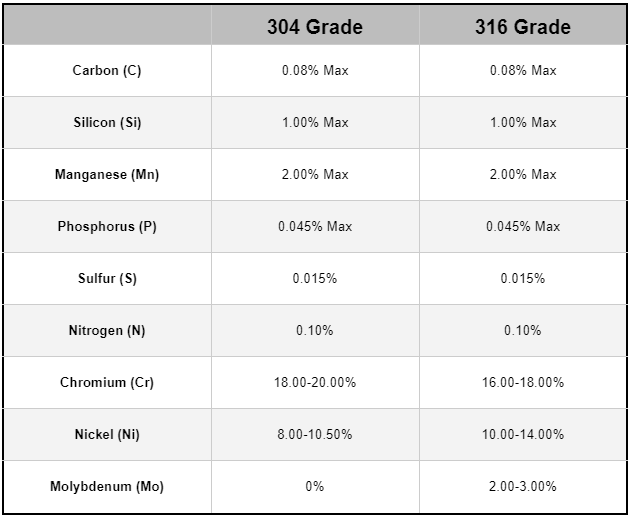Introduction to 300 Series Austenitic Stainless Steel
In the world of metallurgy, stainless steel has become a cornerstone of modern engineering, and the 300 series austenitic grades stand out as some of the most versatile and widely used materials. These alloys are known for their excellent combination of strength, ductility, and corrosion resistance, making them ideal for a broad range of applications. Among these, grades like 304 and 316 are particularly renowned for their durability, aesthetic appeal, and performance in both everyday and demanding environments.

The Foundation of Stainless Steel: Chromium
Chromium is the key ingredient that gives stainless steel its name and its defining characteristic—corrosion resistance. At least 10% chromium by weight is required in all stainless steels, and this element reacts with oxygen in the air to form a thin, protective oxide layer on the surface. This passive film prevents further oxidation and protects the underlying metal from rust and degradation, even in harsh conditions.
304 Stainless Steel: The Versatile Workhorse
Grade 304 is one of the most commonly used austenitic stainless steels, often referred to as 18/8 due to its composition of 18% chromium and 8% nickel. It offers excellent corrosion resistance, good formability, and high tensile strength. Because of its versatility, 304 is used in everything from kitchen appliances and food processing equipment to architectural components and industrial machinery. Its cost-effectiveness and wide availability make it a popular choice across many industries.
316 Stainless Steel: The Corrosion-Resistant Champion
Building upon the properties of 304, grade 316 adds molybdenum to the mix, which significantly enhances its resistance to pitting and crevice corrosion—especially in chloride-rich environments. With approximately 16% chromium, 10% nickel, and 2% molybdenum, 316 is well-suited for use in marine settings, chemical processing, and pharmaceutical applications where exposure to saltwater or aggressive chemicals is common.
A Comparative Look: 304 vs 316 Stainless Steel
While both 304 and 316 are part of the 300 series and share similar characteristics, they serve different purposes. 304 is more economical and suitable for general-purpose applications, while 316 excels in more corrosive or specialized environments. Choosing between them depends on the specific requirements of the application, such as exposure to salt, acid, or high humidity.
Welding and Forming: The Common Strengths
Both 304 and 316 are highly weldable and formable, making them ideal for complex shapes and structures. They cannot be heat-treated for hardening, but cold working can increase their strength. For applications requiring better weldability and lower carbon content, the "L" versions (like 304L and 316L) are preferred, as they reduce the risk of intergranular corrosion during welding.
Typical Uses Across Diverse Industries
304 stainless steel is widely used in kitchens, restaurants, and commercial buildings due to its durability and ease of cleaning. It's also common in automotive parts, HVAC systems, and consumer goods. In contrast, 316 is favored in marine environments, offshore platforms, and medical devices where long-term performance and reliability are critical.
In the chemical industry, 316 is used for tanks, piping, and reactors exposed to corrosive substances. Its ability to withstand extreme conditions makes it a top choice for engineers and designers looking for long-lasting, low-maintenance solutions.
Super Austenitic Grades: Extending Performance
For even more extreme conditions, super austenitic stainless steels take performance to the next level. These grades contain higher levels of nickel and sometimes additional elements like nitrogen or tungsten, providing exceptional resistance to corrosion, stress, and high temperatures. They are often used in deep-sea exploration, chemical processing, and high-performance aerospace components.
Compositions of Austenitic Stainless Steel
Frequently Asked Questions
1. What makes 304 and 316 stainless steel resistant to corrosion?
The presence of chromium creates a protective oxide layer that prevents rust and corrosion. In 316, the addition of molybdenum enhances this protection, especially in environments with chlorides or saltwater.
2. How does the addition of molybdenum enhance the properties of 316 stainless steel?
Molybdenum improves resistance to pitting and crevice corrosion, making 316 more suitable for marine and chemical environments where other stainless steels might fail.
3. What are super austenitic grades, and how do they differ from 304 and 316?
Super austenitic grades have higher nickel and alloying element content, offering superior corrosion and heat resistance. They are used in the most demanding applications where standard 304 or 316 would not perform adequately.
Shop Stainless Steel Instrumentation Fittings
Shop Stainless Steel Cast 150# Fittings
Shop Stainless Steel Nipples
Shop Stainless Steel Forged 3000# Fittings
Shop Stainless Steel Flanges
Shop Stainless Steel Weld Fittings
Shop Stainless Steel Tubing
Plain Brass Tube,Seamless Brass Round Tube,C26200 Tube,Alloy Seamless Tube
TAICANG CITY JINXN COPPER TUBE CO.,LTD , https://www.jinxincopperpipes.com
![<?echo $_SERVER['SERVER_NAME'];?>](/template/twentyseventeen/skin/images/header.jpg)